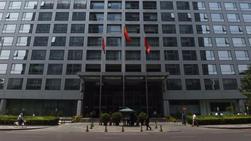 A general view shows people walking outside the China Securities Regulatory Commission building in Beijing on July 9, 2015. (Greg Baker / AFP)
A general view shows people walking outside the China Securities Regulatory Commission building in Beijing on July 9, 2015. (Greg Baker / AFP)
China's mutual funds are expected to maintain high growth at an annualized rate of 18 percent from 2019 to 2025 as a result of the country's capital market reform, said McKinsey & Co.
Another big factor is the accelerated implementation of new asset management rules unveiled in 2018.The rules now regulate the asset management businesses of financial institutions, and have already helped restructure the asset management market, the global management consulting firm said.
To bridge the gap between leading mutual funds in China and the rest of the world, McKinsey said Chinese mutual funds must build up core competencies in areas like research and development, product management, retail channel distribution, comprehensive risk management, digital marketing, and data-driven asset management
The rules require commercial banks to make a transition from offering principal-protected wealth management products toward offering WMPs valued on a net asset basis, which refer to non-principal-protected WMPs with floating rates of return, so that investors can make investments at their own risk based on a solid understanding of the risks.
Total assets under management, or AUM, of financial institutions delivering active investment strategies, such as mutual funds, private security investment funds, private equity investment funds, and insurance asset management companies, reached more than 59 trillion yuan (US$9.13 trillion) in the first half of 2020. They accounted for 51 percent of China's total AUM.
The proportion surpassed that of trust companies and the wealth management subsidiaries of brokerages and banks for the first time, said McKinsey in a report on Thursday.
Many mutual funds launched alternative solutions targeting the wealth management subsidiaries of commercial banks this year, to help them make a better transition toward offering WMPs valued on a net asset basis, said Ma Ben, partner at McKinsey.
Total AUM of China's mutual funds rose to 18 trillion yuan in 2020, up from 14 trillion yuan in 2019 and 11 trillion yuan in 2017, said Ba Shusong, chief economist at the China Banking Association.
Apart from growth acceleration in terms of market size last year, the mutual funds market also experienced structural changes.
In the past, individual investors usually bought stocks on their own, but more and more investors have now become used to investing in the capital market via funds or via asset management companies or AMCs. So, the influence of institutional investors on the market has significantly increased, Ba said.
ALSO READ: Shanghai aims to be asset management hub
"The money from individual investors will become a major source of new funding for China's mutual funds," said Ma at McKinsey.
"A large number of investors have increasingly accepted the idea of long-term investing and asset allocation. As banks' explicit and implicit guarantees to investors on wealth management products, which we call 'a free lunch', are coming to an end, individual investors become increasingly focused on how to achieve their investment goals by allocating assets into financial products that have some fluctuations," he said.
Compared with the market size of US mutual funds, which now stands for 120 percent of US GDP, the market size of Chinese mutual funds stands for about 17 percent of China's GDP. So, it has tremendous potential for growth, the McKinsey report stated.
To bridge the gap between leading mutual funds in China and the rest of the world, McKinsey said Chinese mutual funds must build up core competencies in areas like research and development, product management, retail channel distribution, comprehensive risk management, digital marketing, and data-driven asset management.
McKinsey forecast that China's total AUM will hit 196 trillion yuan in 2025, up from 116 trillion yuan in the first half of 2020. The annual growth of AUM will exceed 9 percent on average from 2019 to 2025.
READ MORE: Lenders' wealth management products stay the reform course


